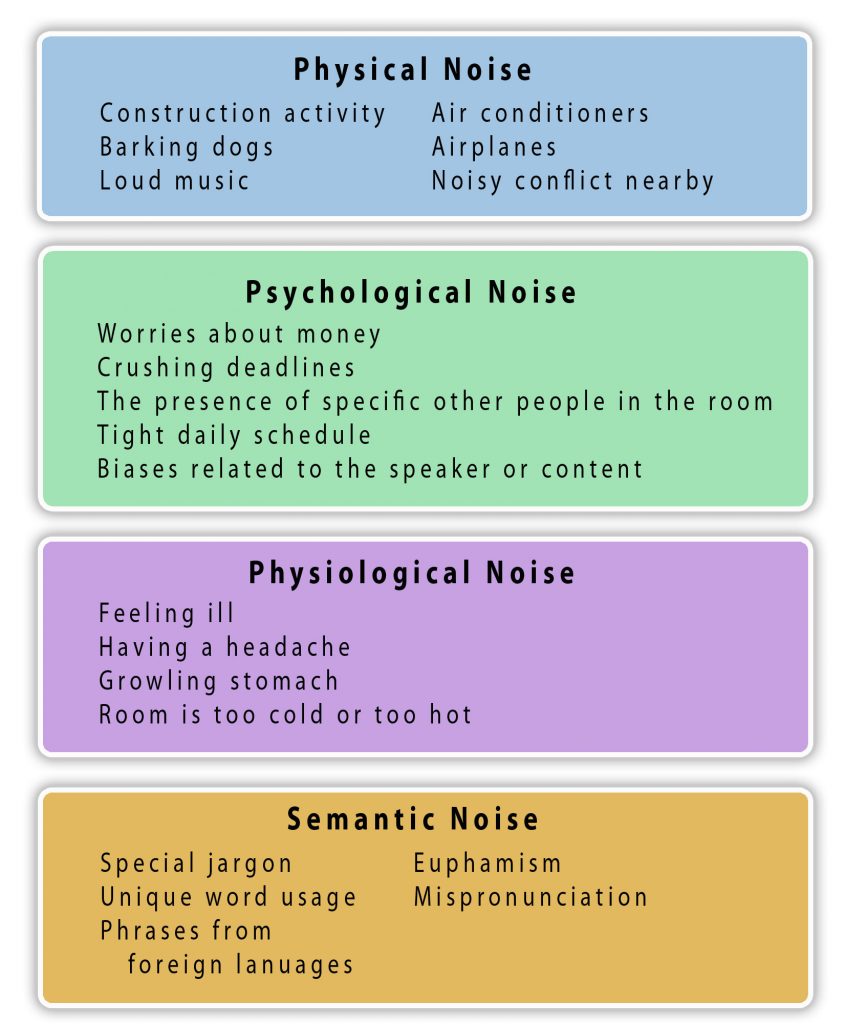Chapter 4 Listening
4.3 Why Listening Is Difficult
Department of Communication, Indiana State University
Why Listening Is Difficult
At times, everyone has difficulty staying completely focused during a lengthy presentation. We can sometimes have difficulty listening to even relatively brief messages. Some of the factors that interfere with good listening might exist beyond our control, but others are manageable. It’s helpful to be aware of these factors so that they interfere as little as possible with understanding the message.
Noise
Noise is one of the biggest factors to interfere with listening; it can be defined as anything that interferes with your ability to attend to and understand a message. There are many kinds of noise, but we will focus on only the four you are most likely to encounter in public speaking situations: physical noise, psychological noise, physiological noise, and semantic noise.

Physical Noise
Physical noise consists of various sounds in an environment that interfere with a source’s ability to hear. Construction noises right outside a window, planes flying directly overhead, or loud music in the next room can make it difficult to hear the message being presented by a speaker even if a microphone is being used. It is sometimes possible to manage the context to reduce the noise. Closing a window might be helpful. Asking the people in the next room to turn their music down might be possible. Changing to a new location is more difficult, as it involves finding a new location and having everyone get there.
Psychological Noise
Psychological noise consists of distractions to a speaker’s message caused by a receiver’s internal thoughts. For example, if you are preoccupied with personal problems, it is difficult to give your full attention to understanding the meanings of a message. The presence of another person to whom you feel attracted, or perhaps a person you dislike intensely, can also be psycho-social noise that draws your attention away from the message.
Physiological Noise
Physiological noise consists of distractions to a speaker’s message caused by a listener’s own body. Maybe you’re listening to a speech in class around noon and you haven’t eaten anything. Your stomach may be growling and your desk is starting to look tasty. Maybe the room is cold and you’re thinking more about how to keep warm than about what the speaker is saying. In either case, your body can distract you from attending to the information being presented.
Semantic Noise
Semantic noise occurs when a receiver experiences confusion over the meaning of a source’s word choice. While you are attempting to understand a particular word or phrase, the speaker continues to present the message. While you are struggling with a word interpretation, you are distracted from listening to the rest of the message. An example of semantic noise is a euphemism. Euphemism is diplomatic language used for delivering unpleasant information. For instance, if someone is said to be “flexible with the truth,” it might take us a moment to understand that the speaker means this person sometimes lies.
Many distractions are the fault of neither the listener nor the speaker. However, when you are the speaker, being aware of these sources of noise can help you reduce some of the noise that interferes with your audience’s ability to understand you.
- "5.4: Why Listeing is Difficult". Introduction to Public Communication. Department of Communication, Indiana State University. Creative Commons Attribution-ShareAlike 4.0 International License. ↵

